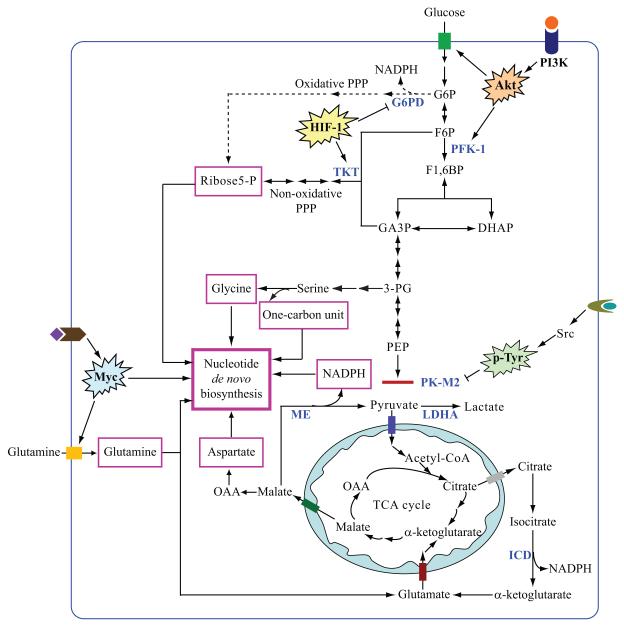Figure 1.
Regulation of glycolysis, glutaminolysis and de novo nucleotide biosynthesis in tumor cells. Oncogenic activation of the PI3K/Akt and Myc pathways promotes glucose and glutamine uptake and catabolism. Tumor cells obtain precursors (in pink rectangles) including ribose 5-phosphate, glycine, glutamine, aspartate and NADPH for de novo biosynthesis from glucose and glutamine metabolism. Increased glucose uptake and PFK-1 activity by the PI3K/Akt pathway, inactivation of PK-M2 by p-Tyr signaling, as well as HIF-1-induced TKT activation allows glycolytic intermediates to enter the non-oxidative PPP for ribose 5-phosphate production in tumor cells. Hatched lines indicate that the oxidative arm of PPP is not the main pathway for ribose 5-phosphate or NADPH production in tumor cells. Glutamine is converted to lactate if mitochondrial malate is exported into the cytoplasm and decarboxylated to produce pyruvate by malic enzyme (ME). The glutaminolysis pathway and the reaction catalyzed by cytosolic isocitrate dehydrogenase (ICD) may serve as the major sources of NADPH for de novo nucleotide biosynthesis in tumor cells [9,52,53]. In addition to its role in providing tumor cells with NADPH, Myc also directly regulates several genes encoding key enzymes in the purine and pyrimidine biosynthetic pathway. Abbreviations: P, phosphate; G6P, glucose 6-phosphate; F6P, fructose 6-phosphate; F1,6BP, fructose 1,6-bisphosphate; GA3P, glyceraldehyde 3-phosphate; DHAP, dihydroxyacetone phosphate; 3-PG, 3-phosphoglycerate; PEP, phosphoenolpyruvate; OAA, oxaloacetate; G6PD, glucose 6-phosphate dehydrogenase; PFK-1, phosphofructokinase-1; TKT, transketolase; PK-M2, pyruvate kinase M2; LDHA, lactate dehydrogenase A; ME, malic enzyme; ICD, isocitrate dehydrogenase.

